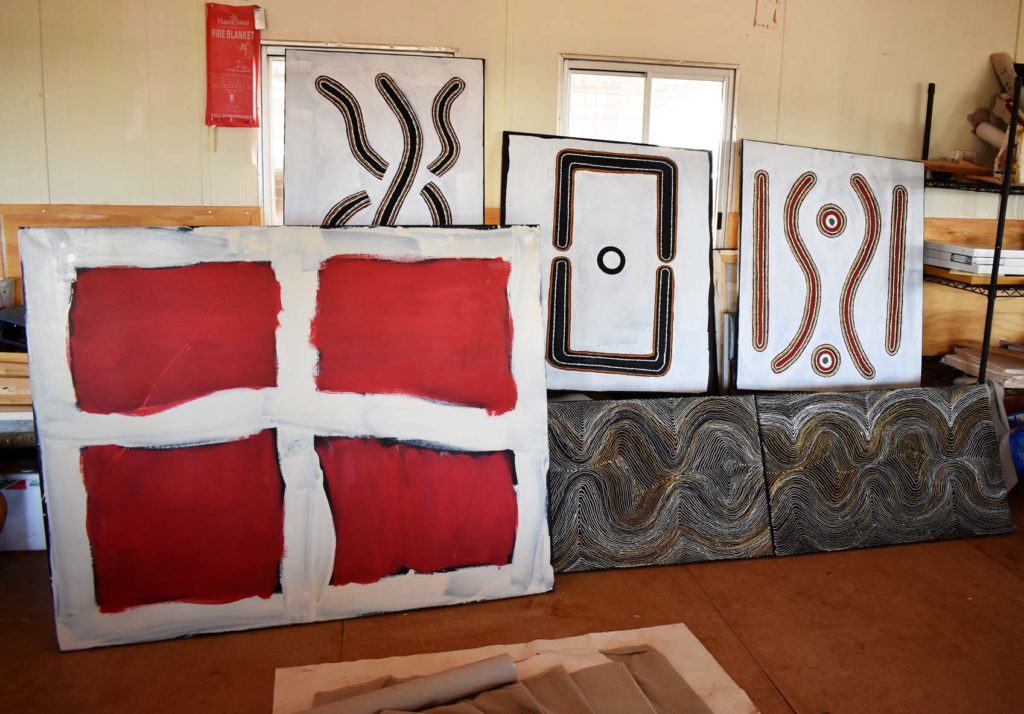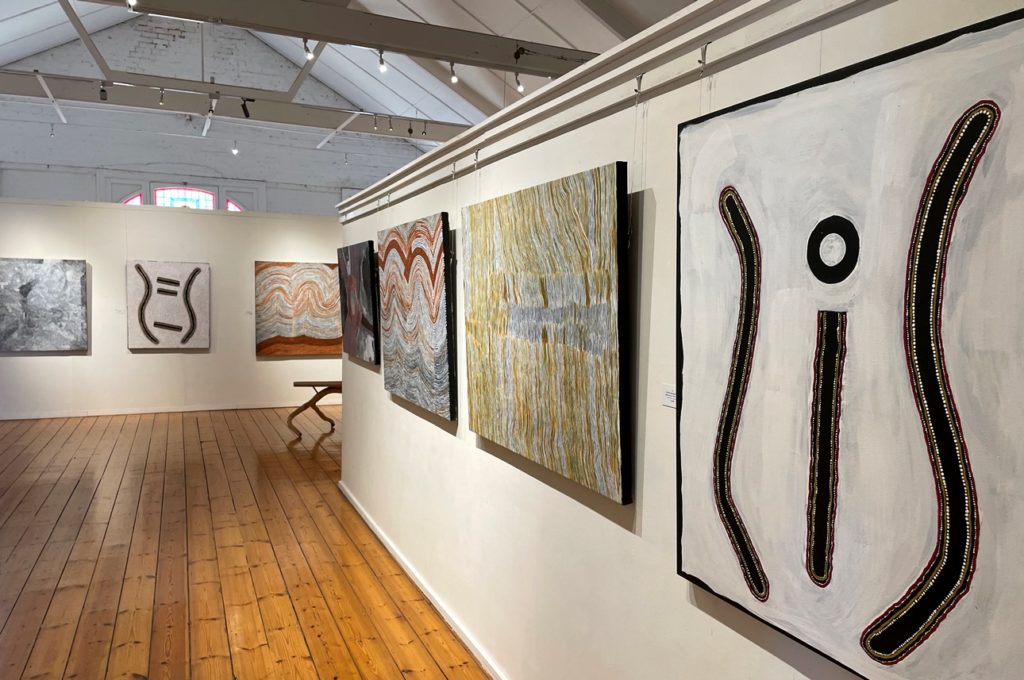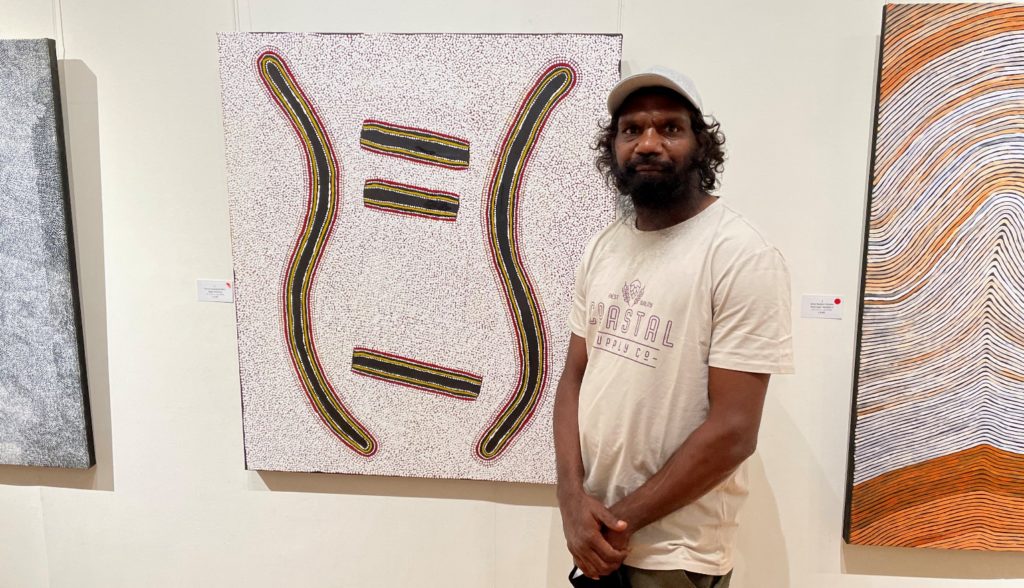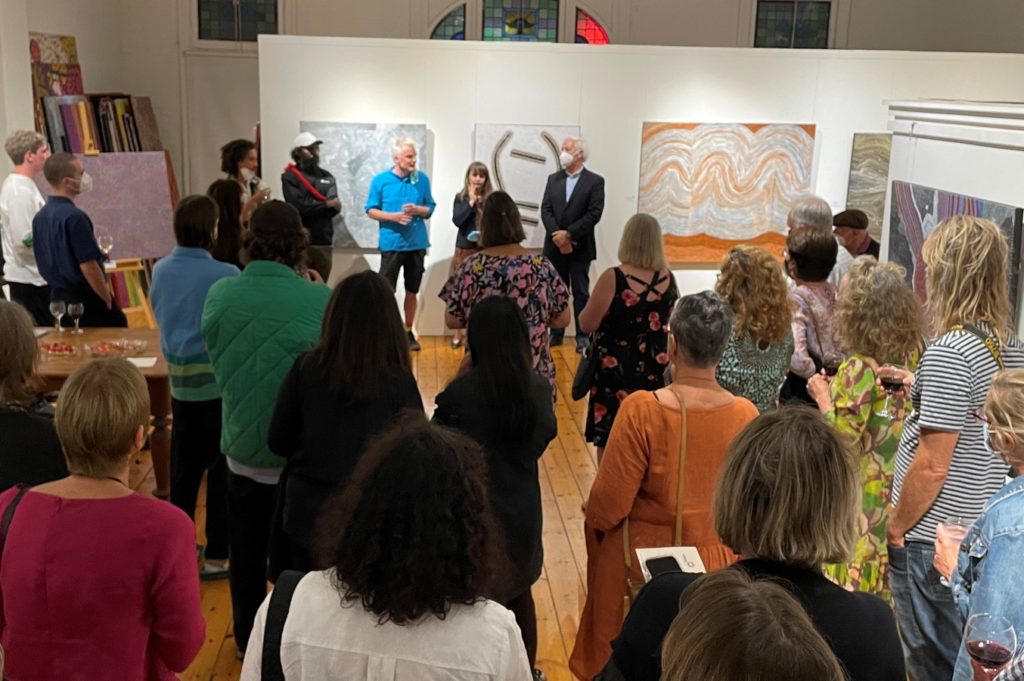New Artists Of The Western & Central Desert
Dr Darren Jorgensen is a Senior Lecturer and Art Historian at University of Western Australia. He reflects on the exciting new exhibition from Ali Curung and the history of that region and the Western Desert Art Movement. He talks about the difference between seeing works back in the studio and then as a curated collection on the gallery wall.
Can you describe who you work for and what your role is there?
I work as an art historian at the University of Western Australia. A lot of my work has been focused on documenting and writing about art from the Western Desert.
The Western Desert Art Movement is really where the dot paintings of Australia originated. That's a history that's been going on since the 1970s. Now that contemporary art making is spread right across the country. Somewhere around 50 communities, depending what you count as a Western Desert community, have artists in them who are consistently producing dot painting.
It's quite possible to be able to tell one community style from another and one artist from another. Quite often Western Desert painting gets mixed up into the same bag as one art movement. Really there are lots of smaller movements within that.
You recently visited Ali Curung. Can you tell us about that community?
I travelled through remote communities as part of my work. I'm very lucky to be able to do that because a lot of these places are very difficult to access. At the end of last year, I went to Ali Curung where the current Japingka exhibition comes from. I saw the paintings when they were still at the studio in Ali Curung.
It's a very interesting area up there. It's really off the map and not well known. It's a populous community. There are hundreds of people living there from four different language groups. Part of the reason that no one has ever heard of it is that it was designed to be out of the way. The original people who designed the community wanted to put the Aboriginal people, who had gathered around the Tennant Creek Telegraph Station, somewhere else. Somewhere that wasn't going to be in the way of the mining that was developed around there after the 1930s.
Cattle Country
So the history of that area is really one in which people have been running cattle and running these massive pastoral stations. It's much more fertile than further south in the desert. It's around where the desert starts to become more fertile as you drive north from Alice Springs.
Mining History
There is also a mining history I had no idea about before I really went up to that area. All the roads around there were really built to facilitate the work of these mines. Some are historic mine sites and others have only been going in only recent times. So they are part of the landscape around this area.
Water Underground
Ali Curung is in a community that used to be called Warrabri. They put the community there because it was one of the places that you could get water because it's not like there's an open water source. It's not like there's a water hole, but there's water close to the surface from the underground aquifers.
At the moment, local authorities are proposing to pull out a lot of that water for a local agriculture scheme that may come to nothing. These desert schemes can often struggle with the harsh conditions.
Coming Together
Originally Tennant Creek was about four or five different language groups that all drifted in. Particularly after the Coniston massacre in the 1930s. People got out of the desert and made sure they were close to settlements. Those four language groups are Warlpiri, Kaytetye, Anmatyerre and Warumungu. They've all gathered together so it's a very cosmopolitan place.
In the '50s and '60s they had film screenings every week and people were still living there working on the mines. There's a whole history of Aboriginal people working the mines around there and on the pastoral stations. To me it's quite remarkable that it's just so off the map.


A Significant First Exhibition
The art exhibition this art centre produced for Japingka is really historic. If you look back at all the different art centres from around Australia and see when they first had their exhibitions, those big moments in history, you can see how new this art is. Papunya exhibited originally in the early '70s in Alice Springs. That was a big deal. Other art centres like Balgo and Fitzroy Crossing started exhibiting in the late '80s and these were historic moments.
Now we see all of these artists from Ali Curung stepping forward with their own exhibition. They have been very much a part of this history and people living very close to their traditional lands and keeping up the old ceremonial traditions. This is a remarkable Japingka exhibition that's tied to all of these different language groups that have gathered in Ali Curung.
You can see the close dot work of Utopia in the works by Judy Long. You can see the male ceremonial tradition in Warrick Japangardi Miller’s work. Warrick has inherited the rainmaking tradition. One day not long away, he'll have a bone through his nose because he's inheriting all these traditions from his elders. These artworks are part of this tradition to remind us that these people are living out there. They're still part of their traditional world that has been going out there, despite these immense disruption, for tens of thousands of years.
At the same time they're also part of this modern art movement. That's the genius of a lot of Western Desert artists because they adapt for us that classical traditional iconography, classic traditional way of seeing land into modernity.
Place of History
During my visit to Ali Curung I saw a lot of artifacts that the art centre has collected. From the perspective of an art historian it was exciting to be seeing these artifacts that no one has really written about before.
Right beside these fascinating historical artifacts, there were these fresh painters with their new ideas. I was bouncing around trying to work out who was who and what was what and what was going on. I was trying to work out the relationship between a lot of the carving, all the carving practices and the new paintings.


Place of Excitement
It's also very dynamic because there were a lot of people there. It was exciting to be among the crowd of Indigenous artists working on their art. I could feel that they were very excited about what they were doing. This upcoming exhibition was something historic for them because they had never really done it before. It was fresh and exciting and I think you can feel that energy in the work. It's quite a moving moment in their history to be present for.
My work is trying to document some of the history. I've seen that this type of documentation is valuable for future artists from that community. A book I wrote a few years ago had artworks and pictures from a bunch of elderly artists who were near the end of their lives. The book was full of the memories of those people. Those books are very much valued in their communities. At Ali Curung, you see artists like Warrick looking back at early work by his grandfather that was documented some time ago.
What did you think of the exhibition on the walls at Japingka Gallery?
I think Japingka is a warm and welcoming sort of a space. It almost feels like an art centre in that the office space is mixed up with what could well be a studio/residency space/mixed up with a gallery. It's a very friendly sort of gallery.
I was amazed that there were so many works there and that they were hanging so close together. I thought it was quite remarkable that there was such a buzz of interest in the works themselves.
The paintings were of such quality and they worked so well together. To me this was quite unexpected because a lot of those works are quite different. Seeing them all curated in this way did give me more of a sense that there is an overall style at the art centre. I hadn't actually seen that before. There is an overall sensibility or feeling that the artists are developing alongside each other. In the exhibition, you can see works that are quite different sitting next to each other and that they bounce off each other.
Back in the arts centre you might see a row of Warrick's work up next to each other. I assumed that the artists would all be separated up on the walls at Japingka. People think about those artists as quite distinct people with distinct histories so naturally they might separate them in their minds.
For this reason, it is a revelation to see the curator mixing them up. David Wroth has hung Warrick's works next to Judy's works and next to the others' work. This gives us much more of a sense that this art centre has a certain style coming through. There is something about the work that goes together to let us identify this as art as coming from this particular art centre. That is exciting and it creates a new perspective that can't be seen back at Ali Curung where the works originated. This is not a studio hang. This exhibition is a salon hang and it elevates and celebrates this as a first historical exhibition. It was a pleasure to see it.
View
Arlpwe Artists: Off the Beaten Track
Read
Arlpwe Artists Exhibition Walk Through
A Day In The Life of Arlpwe Art & Culture Centre Manager
Off the Beaten Track: The Artists of Ali Curung
Aboriginal Communities Bring The Berndt Museum To Life
